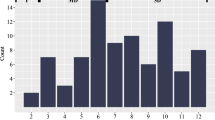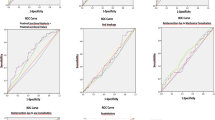Abstract
Background
Several methodologies have been proposed to determine ideal ASD sagittal spinopelvic alignment (SRS–Schwab classification) global alignment and proportion (GAP) score, patient age-adjusted alignment). A recent study revealed the ability and limitations of these methodologies to predict PJK. The aim of the study was to develop a new approach, inspired by SRS classification, GAP score, and age-alignment to improve the evaluation of the sagittal plane.
Method
A multi-center ASD database was retrospectively evaluated for surgically treated ASD patients with complete fusion of the lumbar spine, and minimum 2 year follow-up. The Sagittal age-adjusted score (SAAS) methodology was created by assigning numerical values to the difference between each patient’s postoperative sagittal alignment and ideal alignment defined by previously reported age generational norms for PI-LL, PT, and TPA. Postoperative HRQOL and PJK severity between each SAAS categories were evaluated.
Results
409 of 667 (61.3%) patients meeting inclusion criteria were evaluated. At 2 year SAAS score showed that 27.0% of the patients were under-corrected, 51.7% over-corrected, and 21.3% matched their age-adjusted target. SAAS score increased as PJK worsened (from SAAS = 0.2 for no-PJK, to 4.0 for PJF, p < 0.001). Post-operatively, HRQOL differences between SAAS groups included ODI, SRS pain, and SRS total.
Conclusion
Inspired by SRS classification, the concept of the GAP score, and age-adjusted alignment targets, the results demonstrated significant association with PJK and patient reported outcomes. With a lower rate of failure and better HRQOL, the SAAS seems to represent a “sweet spot” to optimize HRQOL while mitigating the risk of mechanical complications.







Similar content being viewed by others
Change history
23 December 2022
A Correction to this paper has been published: https://doi.org/10.1007/s43390-022-00630-5
References
Smith JS, Singh M, Klineberg E et al (2014) Surgical treatment of pathological loss of lumbar lordosis (flatback) in patients with normal sagittal vertical axis achieves similar clinical improvement as surgical treatment of elevated sagittal vertical axis: clinical article. J Neurosurg Spine 21(2):160–170. https://doi.org/10.3171/2014.3.SPINE13580
Bridwell KH, Glassman S, Horton W et al (2009) “Does treatment (nonoperative and operative) improve the two-year quality of life in patients with adult symptomatic lumbar scoliosis: a prospective multicenter evidence-based medicine study. Clin Trial. https://doi.org/10.1097/BRS.0b013e3181a8fdc8
Smith JS, Klineberg E, Lafage V et al (2016) Prospective multicenter assessment of perioperative and minimum 2 year postoperative complication rates associated with adult spinal deformity surgery. J Neurosurg Spine 25(1):1–14. https://doi.org/10.3171/2015.11.SPINE151036
Kim HJH, York PJP, Elysee JC et al (2020) Cervical, thoracic, and spinopelvic compensation after proximal junctional kyphosis (PJK): does location of PJK Matter? Glob Spine J 10(1):6–12. https://doi.org/10.1177/2192568219879085
Lee J, Park Y-SS (2016) Proximal junctional kyphosis: diagnosis, pathogenesis, and treatment. Asian Spine J 10(3):593–600. https://doi.org/10.4184/asj.2016.10.3.593
Hart RA, Prendergast MA, Roberts WG, Nesbit GM, Barnwell SL (2008) Proximal junctional acute collapse cranial to multi-level lumbar fusion: a cost analysis of prophylactic vertebral augmentation. Spine J. https://doi.org/10.1016/j.spinee.2008.01.015
Lafage R, Schwab F, Challier V et al (2016) Defining spino-pelvic alignment thresholds: should operative goals in adult spinal deformity surgery account for age? Spine. https://doi.org/10.1097/BRS.0000000000001171
Yilgor C, Sogunmez N, Boissiere L et al (2017) Global alignment and proportion (GAP) score: development and validation of a new method of analyzing spinopelvic alignment to predict mechanical complications after adult spinal deformity surgery. J Bone Joint Surg Am 99(19):1661–1672. https://doi.org/10.2106/JBJS.16.01594
Lafage R, Schwab F, Glassman S et al (2017) Age-adjusted alignment goals have the potential to reduce PJK. Spine. https://doi.org/10.1097/BRS.0000000000002146
Scheer JK, Lafage R, Schwab FJ et al (2018) Under correction of sagittal deformities based on age-adjusted alignment thresholds leads to worse health-related quality of life whereas over correction provides no additional benefit. Spine. https://doi.org/10.1097/BRS.0000000000002435
Bari TJ, Ohrt-Nissen S, Hansen LV, Dahl B, Gehrchen M (2019) Ability of the global alignment and proportion score to predict mechanical failure following adult spinal deformity surgery—validation in 149 patients with two-year follow-up. Spine Deform 7(2):331–337. https://doi.org/10.1016/j.jspd.2018.08.002
S. Champain, K. Benchikh, a. Nogier, C. Mazel, J. De Guise, and W. Skalli, “Validation of new clinical quantitative analysis software applicable in spine orthopaedic studies.,” Eur. Spine J., vol. 15, no. 6, pp. 982–91, Jun. 2006, doi: https://doi.org/10.1007/s00586-005-0927-1.
Lafage R, Bess S, Glassman S et al (2017) Virtual modeling of postoperative alignment after adult spinal deformity surgery helps predict associations between compensatory spinopelvic alignment changes, overcorrection, and proximal junctional kyphosis. Spine. https://doi.org/10.1097/BRS.0000000000002116
Lafage V, Schwab FJ, Vira S, Patel A, Ungar B, Farcy JPP (2011) Spino-pelvic parameters after surgery can be predicted: a preliminary formula and validation of standing alignment. Spine. https://doi.org/10.1097/BRS.0b013e3181eb9469
Glattes RC, Bridwell KH, Lenke LG et al (2005) Proximal junctional kyphosis in adult spinal deformity following long instrumented posterior spinal fusion: incidence, outcomes, and risk factor analysis. Spine. https://doi.org/10.1097/01.brs.0000169451.76359.49
Lafage R, Schwab FJ, Bess S et al (2015) Redefining radiographic thresholds for junctional kyphosis pathologies. Spine J 15(10):S216. https://doi.org/10.1016/j.spinee.2015.07.307
Lafage R, Line BG, Gupta S et al (2017) Orientation of the upper-most instrumented segment influences proximal junctional disease following adult spinal deformity surgery. Spine. https://doi.org/10.1097/BRS.0000000000002191
Lafage V, Schwab F, Patel A, Hawkinson N, Farcy JP (2009) Pelvic tilt and truncal inclination: two key radiographic parameters in the setting of adults with spinal deformity. Spine. https://doi.org/10.1097/BRS.0b013e3181aad219
Protopsaltis T, Schwab F, Bronsard N et al (2014) The T1 pelvic angle, a novel radiographic measure of global sagittal deformity, accounts for both spinal inclination and pelvic tilt and correlates with health-related quality of life. J Bone Joint Surg Am 96(19):1631–1640. https://doi.org/10.2106/JBJS.M.01459
Legaye J, Duval-Beaupère G, Hecquet J, Marty C (1998) Pelvic incidence: a fundamental pelvic parameter for three-dimensional regulation of spinal sagittal curves. Eur Spine J 7(2):99–103. https://doi.org/10.1007/s005860050038
Glassman SD, MdBridwell KM et al (2005) The impact of positive sagittal balance in adult spinal deformity. Spine. https://doi.org/10.1097/01.brs.0000179086.30449.96
Vialle R, Levassor N, Rillardon L, Templier A, Skalli W, Guigui P (2005) Radiographic analysis of the sagittal alignment and balance of the spine in asymptomatic subjects. J Bone Joint Surg Am 87(2):260–267. https://doi.org/10.2106/JBJS.D.02043
Inami S, Moridaira H, Takeuchi D, Shiba Y, Nohara Y, Taneichi H (2016) Optimum pelvic incidence minus lumbar lordosis value can be determined by individual pelvic incidence. Eur Spine J 25(11):3638–3643. https://doi.org/10.1007/s00586-016-4563-8
Beyer G, Khalifé M, Lafage R et al (2020) Pelvic compensation in sagittal malalignment: how much retroversion can the pelvis accommodate? Spine. https://doi.org/10.1097/BRS.0000000000003228
Lafage R, Obeid I, Liabaud B et al (2018) Location of correction within the lumbar spine impacts acute adjacent-segment kyphosis. J Neurosurg Spine 30(1):69–77. https://doi.org/10.3171/2018.6.SPINE161468
Yagi M, King AB, Boachie-Adjei O (2012) Incidence, risk factors and natural course of proximal junctional kyphosis: surgical outcomes review of adult idiopathic scoliosis. Minimum 5 years of follow up. Spine. https://doi.org/10.1097/BRS.0b013e31824e4888
Pennington Z, Cottrill E, Ahmed AK et al (2019) Paraspinal muscle size as an independent risk factor for proximal junctional kyphosis in patients undergoing thoracolumbar fusion. J Neurosurg Spine. https://doi.org/10.3171/2019.3.SPINE19108
Hyun S-JJ, Kim YJ, Rhim S-CC (2016) Patients with proximal junctional kyphosis after stopping at thoracolumbar junction have lower muscularity, fatty degeneration at the thoracolumbar area. Spine J 16(9):1095–1101. https://doi.org/10.1016/j.spinee.2016.05.008
Funding
The International Spine Study Group (ISSG) is funded through research grants from DePuy Synthes (current), Nuvasive (current), K2M (current), Innovasis (past), Biomet (past), and individual donations.
Author information
Authors and Affiliations
Consortia
Contributions
RL: conceptualization, data collection and preparation, method and analysis, writing—original draft, writing review/editing. JSS: conceptualization, data collection and preparation, writing—original draft, writing review/editing. JE: conceptualization, data collection and preparation, method and analysis, writing—original draft, writing review/editing. PP: conceptualization, data collection and preparation, writing review/editing. SB: conceptualization, data collection and preparation, Writing review/editing. EK: conceptualization, data collection and preparation, writing review/editing. HJK: conceptualization, data collection and preparation, writing—original draft, writing review/editing. CS: conceptualization, data collection and preparation, writing review/editing. DB: conceptualization, data collection and preparation, writing review/editing. RH: conceptualization, data collection and preparation, writing review/editing, GM: conceptualization, data collection and preparation, writing review/editing. CA: conceptualization, data collection and preparation, writing review/editing. FS: conceptualization, data collection and preparation, writing—original draft, writing review/editing, supervision. VL: conceptualization, data collection and preparation, method and analysis, writing—original draft, writing review/editing, supervision. All authors agree to be accountable for all aspects of the work in ensuring that questions related to the accuracy or integrity of any part of the work are appropriately investigated and resolved. All authors included in the present article have substantially participate to the manuscript and approved the final version of the manuscript.
Corresponding author
Ethics declarations
Conflict of interest
Detail conflict of interest was submitted for each author. None of them are related to the current study.
Ethical approval
IRB approval was obtained at each participating site.
Informed consent
Informed consent was obtained from all individual participants in the study prior enrollment.
Additional information
Publisher's Note
Springer Nature remains neutral with regard to jurisdictional claims in published maps and institutional affiliations.
The original online version of this article was revised: In Fig. 4 of this article signs for points associated in all 3 components are incorrect and should be reversed, e.g + 2 should be −2 and vise versa.
Rights and permissions
Springer Nature or its licensor (e.g. a society or other partner) holds exclusive rights to this article under a publishing agreement with the author(s) or other rightsholder(s); author self-archiving of the accepted manuscript version of this article is solely governed by the terms of such publishing agreement and applicable law.
About this article
Cite this article
Lafage, R., Smith, J.S., Elysee, J. et al. Sagittal age-adjusted score (SAAS) for adult spinal deformity (ASD) more effectively predicts surgical outcomes and proximal junctional kyphosis than previous classifications. Spine Deform 10, 121–131 (2022). https://doi.org/10.1007/s43390-021-00397-1
Received:
Accepted:
Published:
Issue Date:
DOI: https://doi.org/10.1007/s43390-021-00397-1




